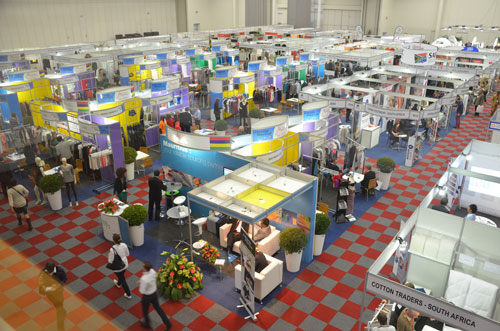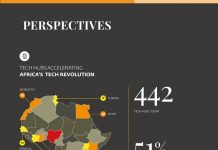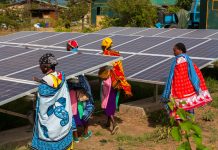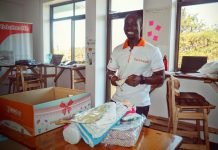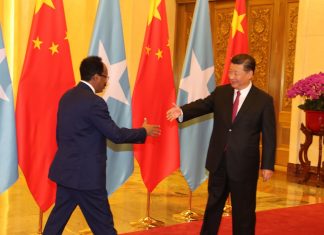At just a year old, Source Africa ranks among the most important tradeshows for African suppliers of textiles, clothing and footwear. The American Apparel and Footwear Association’s (AAFA) involvement indicates the escalating interest of U.S. companies in the continent, both as a sourcing destination and a consumer market.
The U.S. appetite for textile and garment products is huge. The U.S. Department of Commerce’s Office of Textiles and Apparel put demand at $101 billion in 2012. China, the biggest supplier to the United States, accounts for at least 40 percent of the market. By comparison, total apparel exports to the United States from Africa in 2012 valued just about $2 billion.
But rising manufacturing costs in China—buyers say they rose 40 percent in 2013—are driving companies to look elsewhere, including Africa.
“Many companies are moving to other destinations within Asia, but there’s a good number of companies that want to explore and invest in entirely new sourcing locations. And Africa, which continues to be described as the next frontier, is a great option for that,” says Marie D’Avignon, the AAFA’s manager of government relations. “At the same time, many AAFA companies are expanding their sales reach and looking at emerging markets, where Africa again is the next frontier.”
Organized by the USAID Southern Africa Trade Hub in partnership with LTE South Africa, an event management company, and the African Cotton & Textile Industry Federation (ACTIF), Source Africa attracts buyers, manufacturers, suppliers, service providers and investors from across Africa, Europe and the United States. Some 1,400 participants were on hand for its launch in Cape Town, South Africa, in 2013.
The 2014 edition takes place again in Cape Town, from June 18 to 20. It will include a two-day trade exhibition, African country pavilions, business seminars organized by AAFA to share intelligence and resources for companies looking to manufacture and invest in Africa, and a professional online matchmaking program. The expo is expected to feature more than 180 exhibitors and attract more than 2,000 decision makers.
“It is clear that Africa sits on the threshold of new opportunities for export diversification and regional integration in these industries. Moreover, there seems to be an agreement that with higher costs in Asia and the saturation of some key sourcing platforms in Asia and elsewhere, Africa has a chance to become a new sourcing destination,” says Steve Lamar, AAFA’s executive vice president.
AAFA jumped at the chance when USAID approached it about exploring opportunities in Africa. In January, the two organizations and ACTIF agreed to collaborate to boost U.S.-sub-Saharan Africa trade in cotton, textiles and apparel through the exchange of market and import/export policy information, guidance on requirements and best practices, and the promotion of joint solutions to address market constraints. Their memorandum of understanding covers manufacturing in Africa for the U.S. market, as well as creating access for U.S. companies in African markets. The parties agreed to.
A survey of AAFA member companies showed keen interest in the continent, not only for cost, especially in light of duty-free access to the United States under the African Growth and Opportunity Act, but also for the potential of selling to its fast-growing middle class.
In the latter regard, Southern Africa is particularly attractive. Botswana, Lesotho and Swaziland already are among the top five AGOA apparel exporters to the United States. Companies that manufacture in those countries can just as easily supply local markets.
“As those markets become more and more of a draw, companies are looking to explore them, but don’t necessarily want to take a huge risk of making stuff here in the U.S., or making stuff in China and moving it over there and having to deal with extra costs,” D’Avignon said. “However, if they make it right nearby, the cost of shipping drastically reduces.”
Some AAFA members also see manufacturing in Africa as a step toward empowering their brand.
D’Avignon explained. “We asked several companies, ‘why are you in Africa?’ and they literally told us, ‘because we think it’s the right thing to do. We want part of the story for our brand to be that we’re manufacturing in ways that are helping the people who make stuff; that we’re creating jobs in countries where they really need jobs; and that we’re making sure that our factories are in places with ethical treatment of their workers. And we know that Africa is a place that wants more of that and we’re really excited to be there.’”
There are other practical reasons for manufacturing in Africa, says Angela Dean, director of global business development for Partner Africa, a leading nonprofit social enterprise based in Nairobi, Kenya.
“Right now, six out of ten people live in Asia, but in 20 years that will shift to Africa. This is a huge untapped pool of labor, very attractive to companies that are looking further down the line, and especially for manufacturing companies that are moving over into Africa,” she says.
Africa’s export processing zones are another draw because they “provide a better way to do business, an easier way to do business, and reduce a lot of the red tape on the ground, and have favorable tax incentives and customs incentives as well,” Dean says.
Tanzania’s Benjamin William Mkapa Special Economic Zone at Mabibo in Dar es Salaam was a draw for China’s JD United Manufacturing Co., which produces garments primarily for the U.S. market in China and Cambodia. As labor costs rose in those countries, the company and its U.S. clients—including Levi’s and Russell Brands—sought a new place for production, ultimately choosing Tanzania. Among other benefits, they cited the rich incentives of Tanzania’s special economic zone.
JD United opened its first factory in the zone in 2012, with plans to expand. All of its products are exported to the U.S. market under AGOA.


